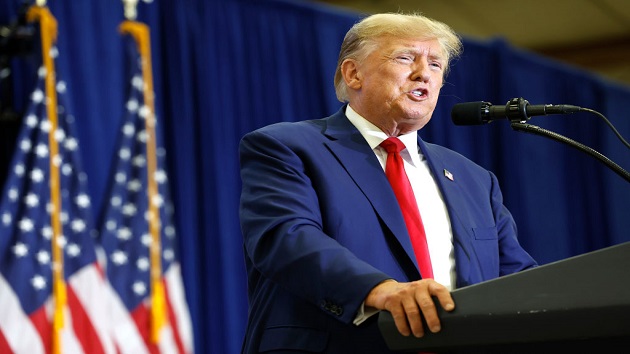(NEW YORK) — Days away from the first ballots cast in the 2024 primary election, former President Donald Trump holds a commanding lead over his Republican rivals and tops President Joe Biden in some head-to-head polls.
Trump’s standing appears to stem in part from widespread frustration over Biden’s handling of the economy. Only 30% of voters approve of what Biden has done on that issue, according to an ABC News/Washington Post poll from the fall.
While such voter sentiment has drawn significant attention, less focus has been paid to what Trump plans to do if he takes the reins of the economy next year.
The Trump campaign did not immediately respond to ABC News’ request for comment.
Here’s what to know about Trump’s economic proposals for a potential second term and how some economists view them:
Trade
Trump plans to ratchet up a confrontational trade policy instituted during his first term, promising to impose tariffs on most imported goods.
Speaking with Fox Business in August, Trump said the tax on imported items could ultimately stand at 10%.
Trump also plans to tighten constraints on China-made products, including a “4-year plan to phase out all Chinese imports of essential goods,” according to a set of proposals released in February.
Stephen Moore, who previously served as an economic adviser to Trump and says he has helped shape Trump’s 2024 agenda, told ABC News that the tariff policies would hinder foreign producers and make domestic industries more competitive.
In turn, the policy would create jobs and boost manufacturing in the U.S., Moore said.
“Trump wants jobs here in America,” Moore added. “He wants things made in America.”
Many economists, including Moore, believe that a near-universal tariff would raise the prices of many consumer goods, however.
The price increases would primarily hurt low- and middle-income households, since consumer spending makes up a disproportionately large share of their expenses, Alan Blinder, a professor of economics at Princeton University and a former member of the Council of Economic Advisors under President Bill Clinton, told ABC News.
Gregory Daco, chief economist at global consulting firm EY, noted that the elevated prices could also weigh on consumer spending and in turn slow economic growth. Plus, he added, the potential shift toward American manufacturing would carry sizable up-front expenses.
“There’s no such thing as a free lunch,” Daco told ABC News. “It takes time to build factories and it costs a lot.”
Tax cuts
The revenue generated by a sweeping set of tariffs would allow the Trump administration to reduce taxes for individuals and companies, the Trump campaign said in February.
But the details of a tax cut proposal remain uncertain, Moore said. “This is all in motion,” Moore added. “Nothing has been decided.”
Trump is committed, however, to extending the tax cuts signed into law during his first term when they begin to phase out in 2025, Moore added.
“He clearly wants to make sure the tax rates don’t go up as they’re supposed to do if they let his tax plan expire,” Moore said.
However, a recent report by the nonpartisan Congressional Budget Office, or CBO, said that making permanent the provisions of the Tax Cuts and Jobs Act of 2017 would add $3.5 trillion to the nation’s deficit.
The U.S. currently holds roughly $31.4 trillion in debt. In a report in February, the CBO projected the federal debt will grow nearly $20 trillion by the end of 2033.
“Extending the tax cuts would only worsen the already deep budget deficit problem that we’re dealing with,” Blinder said.
While the economy registered strong growth over the year after Trump’s tax cut took effect, the measure accounted for little or none of the performance, according to a study from the nonpartisan Congressional Research Service in 2019.
“The tax cuts did not create investment or productivity miracles,” Blinder said. “Nobody should’ve expected that they would.”
Energy
Trump has vowed to slash U.S. energy and electricity costs by ramping up domestic production of fossil fuels.
On the campaign trail, Trump has summed up this approach with a slogan: “Drill, baby, drill.”
The agenda includes tax breaks for producers of oil, gas and coal.
Trump also plans to do away with much of the $369 billion Inflation Reduction Act, the largest climate measure in U.S. history, which includes incentives for clean energy projects and the purchase of electric vehicles, the Financial Times reported in November.
Under Biden, meanwhile, the U.S. set a record for oil output this year. As of December, the country was on pace to increase its supply of oil by an average of 1.4 million barrels per day, according to the International Energy Agency, a government group.
Blinder, of Princeton, questioned a potential expansion in production of fossil fuels, which make up a key driver of climate change. Economic policy should strike a balance between productivity and environmental concerns, Blinder said.
“One basic principle of taxation is you want to tax bad things and subsidize at least some good things,” he added. “I find it hard to see that with providing tax breaks for fossil fuels.”
Copyright © 2024, ABC Audio. All rights reserved.












